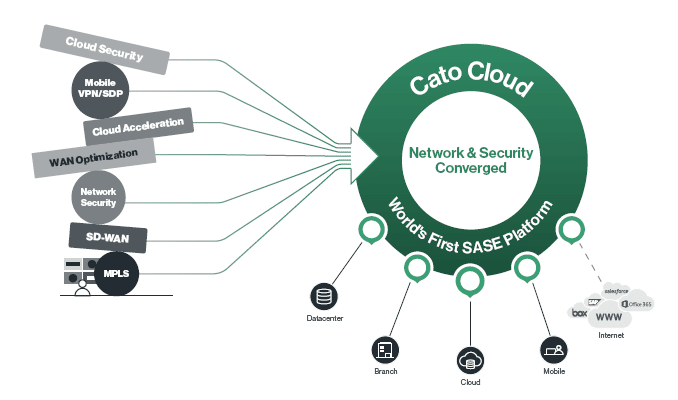Cato Networks Listed as a “Sample Vendor” for Secure Access Service Edge (SASE) category in the Gartner Hype Cycle for Enterprise Networking, 2019
The Secure Access Service Edge (SASE) category converges WAN capabilities and network security. Gartner identifies the benefit rating of this category as “transformational” and notes that “the shift to SASE architecture obsoletes legacy security and networking business models.”**
TEL AVIV, Israel, October 2, 2019 — Cato Networks, the cloud-native carrier, announced today that it has been identified as a Sample Vendor in the Secure Access Service Edge (SASE) category of the Gartner “Hype Cycle for Enterprise Networking, 2019” report.* According to the report, “SASE services will converge a number of disparate network and network security services including SD-WAN, secure web gateway, CASB, software defined perimeter (zero trust network access), DNS protection and firewall as a service.”
“We’re honored to be named by Gartner as a Sample Vendor and believe it shows that Cato is the world’s first SASE platform,” says Shlomo Kramer, CEO and co-founder of Cato Networks, “Since Cato’s founding, we’ve focused on converging networking and security into the cloud, creating one, global, cloud-native architecture that connects and secures all locations, cloud resources, and mobile users everywhere.”

Secure Access Service Edge Will Obsolete Legacy Networking and Security Architectures
SASE is emerging in response to the needs of today’s digital business. Digital transformation forces a rethinking of legacy enterprise networks. Gartner writes, “Digital transformation and adoption of mobile, cloud and edge deployment models fundamentally change network traffic patterns, rendering existing network and security models obsolete.”**
Providing secure access in this new reality and meeting operational requirements will rely heavily on cloud-based services. Gartner writes, “Customer demands for simplicity, scalability, flexibility, low latency and pervasive security force convergence of the WAN edge and network security markets, creating the secure access service edge (SASE), with a predominantly cloud-based, as-a-service delivery model.”**
As a cloud service that supports global enterprises, geographic footprint is critical. Gartner writes, “Many emerging edge applications are latency-sensitive, requiring networking and security delivered in a distributed manner close to the endpoint device or user access. This requires a cloud-delivery-based approach, favoring providers with many points of presence (POPs).”**
SASE will have significant implications for the vendor and the communications service provider (CSP) markets. Gartner writes, “Networking and security vendors that fail to aggressively embrace this transition will lose influence with buyers and will find themselves relegated to market niches with limited prospects”** and “Traditional CSPs are betting that the heavy-branch approach delivered via provider-managed universal CPE will reestablish account control, and deliver much needed margin and revenue growth. SASE is an existential threat to this strategy as CSPs will lack the ability to effectively compete with OTT SASE providers. This mirrors the loss of control CSPs have experienced with the introduction of OTT-delivered SD-WAN services.”**
The Cloud-native Architecture is Critical for SASE Platforms
Converging networking and security is essential to becoming a SASE platform, but this convergence should not be delivered by integrating appliances and in fact requires an appropriate software architecture. “Gartner expects a number of SASE announcements over the next several months as vendors merge or partner to compete in this emerging market. Most SASE offerings will be purpose built for scale-out, cloud-native and cloud-based delivery and optimized to deliver very low latency services. Keep in mind that in the early days of this transition there will be a great deal of slide-ware and marketecture, especially from incumbents that are ill-prepared for the cloud-based delivery model from distributed POPs. This is a case where software architecture and implementation matters. Additionally, be wary of vendors that propose to deliver the broad sent of required services by linking a large number of products via virtual machine service chaining, especially when the products come from a number of acquisitions. This approach may speed time to market but will result in inconsistent services, poor manageability and high latency.”*
Buyers are encouraged to look for SASE platforms with cloud-native architectures. Gartner writes, “To deliver maximum flexibility with the lowest latency and resource requirements, a cloud-native single-pass architecture is advantageous.”**
SASE platforms must have significant geographical reach. Gartner writes, “It isn’t sufficient to offer a SASE service built solely on a hyperscale provider’s limited number of points of presence. To compete effectively and meet requirements for low latency, significant investments in geographically disperse points of presence will be necessary.”*
The proliferation of the mobile workforce requires SASE platforms to go beyond physical locations. Per Gartner, “Some agent-based capabilities will be necessary for policy-based access for user-facing devices and some on-premises based capabilities will be required for networking functions such as QoS and path selection.”*
According to the report, “SASE offerings that rely on an on-premises, box-oriented delivery model or that rely on a limited number of cloud points of presence will be unable to meet the requirements of an increasingly mobile workforce and emerging latency sensitive applications.”*
Cato Delivers a SASE Platform Today
IT managers don’t have to wait for SASE platforms to come to market. Cato provides SASE capabilities, today. Cato Cloud delivers a converged cloud-native network and security platform via 47 PoPs globally, securely connecting all enterprise edges into the WAN and to the Internet. Today, more than 400 enterprises worldwide rely on Cato as their global enterprise network serving thousands of branch offices, cloud instances and mobile users.
Additional Resources
- Read the full text of SASE description from the Gartner Hype Cycle for Enterprise Networking, 2019
- This blog and this whitepaper shows how Cato meets SASE requirement
- Learn more about Cato and it’s SASE offering at www.catonetworks.com
* Gartner, “Hype Cycle for Enterprise Networking, 2019,” Andrew Lerner and Danellie Young, 9 July 2019
** Gartner, “Market Trends: How to Win as WAN Edge and Security Converge Into the Secure Access Service Edge,” Joe Skorupa and Neil MacDonald, 29 July 2019
Disclaimer:
Gartner does not endorse any vendor, product or service depicted in its research publications, and does not advise technology users to select only those vendors with the highest ratings or other designation. Gartner research publications consist of the opinions of Gartner’s research organization and should not be construed as statements of fact. Gartner disclaims all warranties, expressed or implied, with respect to this research, including any warranties of merchantability or fitness for a particular purpose.
About Cato Networks
Cato, the cloud-native carrier, provides the only secure managed SD-WAN service built with the global reach, self-service, and agility of the cloud. Cato replaces MPLS and multiple networking and security point solutions with a converged WAN transformation platform built for the digital business. Using Cato, customers easily migrate from MPLS to SD-WAN, improve global connectivity to on-premises and cloud applications, enable secure branch Internet access everywhere, and securely and optimally integrate cloud datacenters and mobile users into the network. Visit www.catonetworks.com and Twitter: @CatoNetworks.







